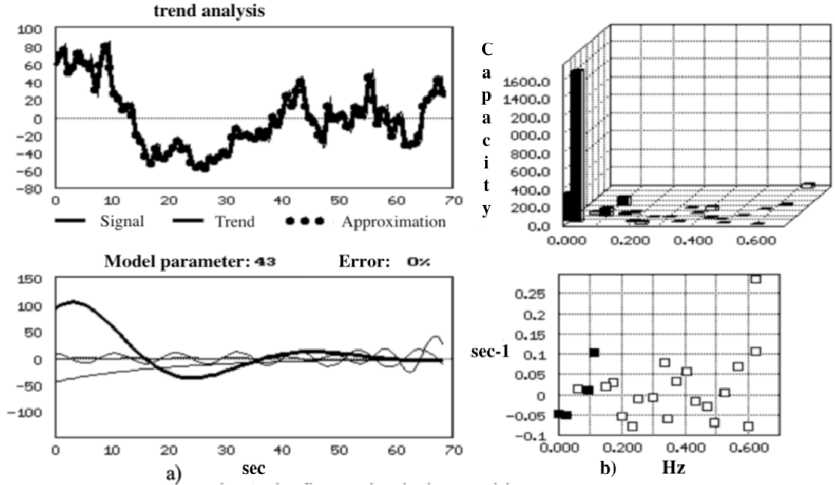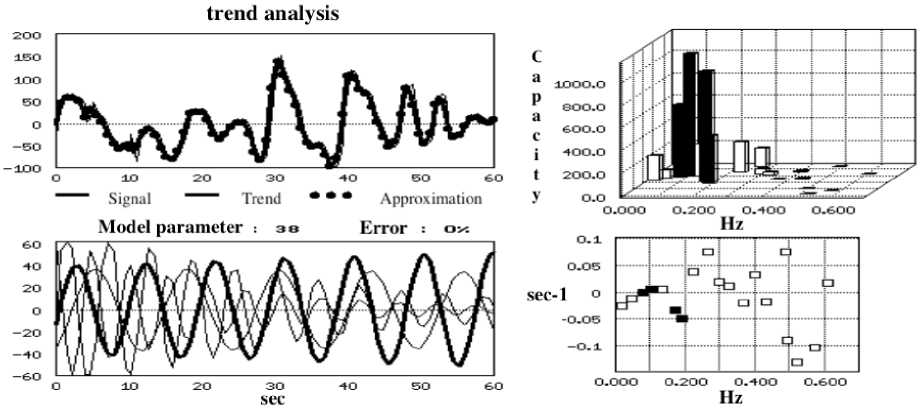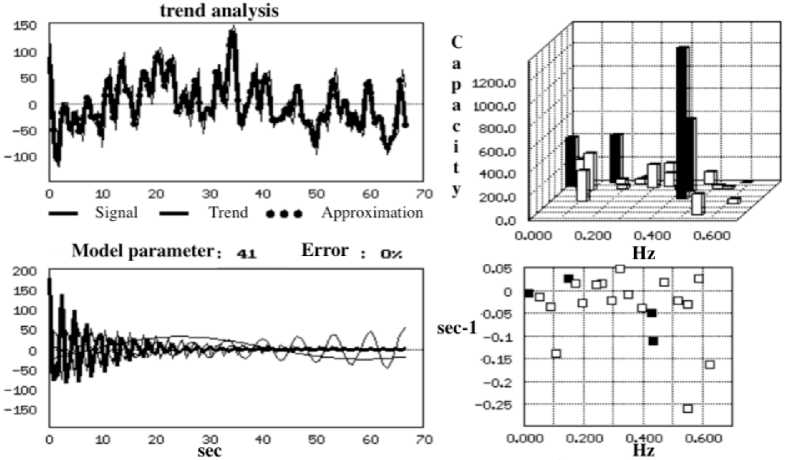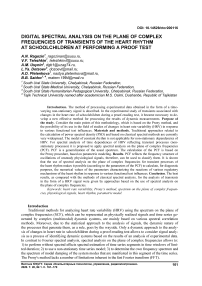Digital spectral analysis on the plane of complex frequencies of transients of the heart rhythmat schoolchildren at performing a proof test
Автор: Ragozin A.N., Telezhkin V.F., Usynin A.M., Dotsoev L.Ya., Pletenkova A.D., Saidov B.B.
Рубрика: Краткие сообщения
Статья в выпуске: 1 т.20, 2020 года.
Бесплатный доступ
Introduction. The method of processing experimental data obtained in the form of a time-varying non-stationary signal is described. In the experimental study of transients associated with changes in the heart rate of schoolchildren during a proof-reading test, it became necessary to develop a new effective method for processing the results of dynamic measurements. Purpose of the study. Consider the main points of this methodology, which is based on the Prony method, and the possibility of its use in the field of studies of changes in heart rate variability (HRV) in response to various functional test influences. Materials and methods. Traditional approaches related to the calculation of power spectral density (PSD) and based on classical spectral methods are currently very widespread. The model of constant rhythm is not applicable for non-stationary dependencies of HRV. For spectral analysis of time dependences of HRV reflecting transient processes (non-stationary processes) it is proposed to apply spectral analysis on the plane of complex frequencies (PCF). PCF is a generalization of the usual spectrum. The calculation of the PCF is based on the Prony procedure, based on parametric modeling. Results. PCF reflects the frequency structure of oscillations of unsteady physiological signals, therefore, can be used to classify them. It is shown that the use of spectral analysis on the plane of complex frequencies for transient processes of the heart rhythm makes it possible (according to the parameters of the PCF) to calculate, for diagnostic purposes, the numerical values of the parameters characterizing the reactions of various regulatory mechanisms of the heart rhythm in response to various functional test influences. Conclusion. The best results, as compared with the methods of classical spectral analysis, for the analysis of transients in the form of a HRV signal were given by approaches based on the use of spectral analysis on the plane of complex frequencies.
Heart rate variability, prony's method, spectrum on the plane of complex frequencies, physiological signals, heart rhythm, parametric model
Короткий адрес: https://sciup.org/147232299
IDR: 147232299 | УДК: 612.17 | DOI: 10.14529/ctcr200116
Текст краткого сообщения Digital spectral analysis on the plane of complex frequencies of transients of the heart rhythmat schoolchildren at performing a proof test
Traditional methods for analyzing heart rate variability (HRV) using the spectrum on the plane of complex frequencies (SCF), which can be represented as physically realized signals and time series generated by complex (multimodal) dynamic systems, are mainly based on various spectral correlation methods. Moreover, due to the statistical approach to the analysis of signals, the dynamic nature of the processes that generate them, as a rule, goes by the wayside. Only a dynamic approach to the analysis of changes in heart rate in schoolchildren during a proof-reading test allows to consider signal analysis as a process of identifying dynamic systems based on the results of an analysis of experimental data. In contrast to Fourier spectral analysis, spectral analysis on the plane of complex frequencies allows to: 1) to perform without spectral effects spectral estimation of time series segments in time windows of limited duration; 2) to use a non-stationary time series model; 3) to determine the own frequency spectrum and the spectrum of modal damping of the system modes that are manifested in this segment of the time series. The Prony's method lacks a number of limitations inherent in the fast Fourier transform (FFT).
Problem statement
The work is devoted to the experimental study of transients of the heart rhythm in three types of state when the heart rate changes in schoolchildren during a proof-reading test. As a research tool, the method of spectral analysis on the plane of complex frequencies is used. The parameters for constructing the spectrum of complex frequencies are: f, α, p – harmonic frequency [Hz], coefficient of harmonic amplitude change according to exponential law [sˉ1] and harmonic power [unit of measure-ment²]. The method expands the possibilities of studying the physiological regulation of transients in the body of children and teenagers during the educational process.
Studying the student’s functional capabilities when performing stress tests is of great practical importance for determining the level of functional tension of the child’s regulatory systems, which is determined by the degree of physiological maturity of the body and environmental conditions. Change in heart rate – a universal operational response of the whole organism to any environmental impact. One of the important links of this mechanism provides a balance between the sympathetic and parasympathetic departments of the autonomic nervous system [1, 2]. Heart rate variability indicators reflect the state of the autonomic nervous system, the degree of tension of regulatory mechanisms, therefore, it is important to study them in children of different ages in conditions of adaptation to school loads, which plays an important role in the prevention of diseases [3, 4]. Transitional states of the physiological system proceed with a pronounced activation of some regulation rhythms and suppression of others, which is manifested by a change in the nature of the structural-temporal organization of vibrational activity [5]. Thus, it is required to show that a deep assessment of the state of the autonomic nervous system is possible through the use of spectral analysis of HRV [6–14].
Solution
It should be noted that when using spectral analysis, the action of the regulation mechanisms during the registration of the heart rhythm should remain constant (stationary observation conditions). The temporary recording of HRV should be the implementation of a stationary random process, that is, the process on average is uniform in time (the variance and mean are constant over time). The transient processes of HRV caused by the influence of a functional test are non-stationary processes and therefore are excluded during the spectral analysis. To analyze transient processes of heart rhythm, the technology of spectral analysis on the plane of complex frequencies is used [15–23].
The calculation of the SCF implies the representation of the studied HRV dependence as the sum of a certain number of sinusoids (harmonics), characterized by a phase, frequency and amplitude, which changes in time (constant α = 0), increasing (α > 0), or decaying (α < 0), by exponential law (eαt). The basis for the algorithm for calculating the SCF is the Prony procedure. The investigated time process of HRV is represented as a set of rhythms with different frequencies, initial phases, but with varying intensities by exponential law. The set of harmonics into which the process under study decomposes must correspond to its nature. The harmonics varying in amplitude reflect the adjustment process and the change in the frequency composition of the process under study. The adjustment process can be observed separately by the generally accepted frequency ranges [16].
The parameters for constructing the SCF HRV are: f – harmonic frequency [Hz], α – coefficient of variation of the harmonic amplitude according to the exponential law [s–1], P – harmonic power [ms²]. SCF is displayed in the form of lines with height P, placed on the plane of the complex frequency (f, α). If the time dependence of the HRV is strictly stationary, then the harmonics into which the studied dependence of the HRV is decomposed will have constant in time amplitudes (α = 0) (intensity) and the SCF takes the form of a usual spectrum [16].
The information content of indicators considered on the basis of the SCF is shown in [16]. The transition process of insertion is based on the activation of the sympathetic and suppression of the parasympathetic departments of the autonomic nervous system, which leads to an increase in the number of heart contractions (HC) and a decrease in heart rate variability (HR). This means that changes in the vibrational activity of the heart rate observed during the transition process of working in should occur in at least three frequency ranges: low-frequency trend (deviation), oscillations at low frequencies (activation and suppression) and at frequencies of respiratory arrhythmia (suppression). In solving the problem of the present work, 71 healthy third-grade students were examined. Heart rate variability was recorded: one minute at rest, running in and exertion while performing a proof test. To study the quantitative and qualitative characteristics of the transition process, spectral analysis was applied on the plane of complex frequencies [15–23]. The energy (E) of increasing and damping oscillations reflects the overall energy balance of the transition process, and the nature of the transition process is quantified by the instability and periodicity indices [15–23]. The instability of the vibrational process refers to the intensity in time of the easing or increasing fluctuations. The instability index (ANN) is calculated as the ratio of the magnitude of the observation period of the transient to the time interval of the change in vibrational energy (attenuation or amplification of the oscillations) e times (e is the Euler number equal to 2.72 ...). The periodicity index (PI) of an unsteady process shows the number of periods that fit into the time interval of a change in vibrational energy by e times.
The greater the modul e of t he instability index, the more pronounced the aperiodic nature of the transition process. Conversely, the larger the module of the periodicity index, the more the trend of the transition process appears to be oscillations that are stable in amplitude. The sign in front of the indi ces of instability and periodicity indicates the decaying or increasing character of the dynamics of the transitional oscillatory process.
Thus, these indicators obtained using spectral analysis o n the plane of complex frequencies contain important information about the str ucture of the transient oscillatory process and c an serve as indicators of the quality of the regulatory system.
The boundaries of the frequency ranges in the spectrum of complex frequencies, from 0 to 0.05 Hz (VLF), 0.05 to 0.15 Hz (LF), 0.15 t o 0.6 Hz (HF), reflect generally accepted ideas a bout the mechanisms of manifestation of the sympatheti c and parasympathetic parts of the autonomic n ervous system. Heart rate transient indicators: E VLF ( ms² ) – transient integrated energy in the frequency range from 0 to 0.05 Hz; E LF (ms²) – frequency transient integrated energy from 0.05 to 0.15 Hz; E HF (ms²) – the integral energy of the transition process in the frequency range from 0 to 0 .6 Hz; PI VLF – periodicity index in the range of frequencies from 0 to 0.05 Hz; INS VLF – heart rate instability index in the range of frequencies from 0 to 0.05 Hz; PI LF – heart rate index in the range of frequencies from 0.05 to 0.15 Hz; INS LF – heart rate instability index in the frequency range from 0.05 to 0.15 Hz; PI HF – heart rate index in the range of frequencies from 0.15 to 0.6 Hz; INS HF – heart rate instability index in the frequency range from 0.15 to 0.6 Hz; Depending on the ratio bet ween the values of E VLF , E LF и E HF we distinguished three variants of heart rate dynami cs in children. The first option, in which the inte grated transient ene r gy prevails at the lowest frequenc ies, so that the ratio of EVLF to the sum of EL F and EHF is gre ater than or equal to 0.5. The basis of the transition process of this option is the oscil lation represented by the low- frequency decaying cosine wave. The spectrum on the plane of complex f requencies has a pr o nounced peak at the corresponding low frequen cy (Fig. 1).

Fig. 1. The first option is the transition process: a) heart rate dynamics, b) the spectrum of heart rate transition on the plane of complex frequencies
I n t he se c on d op tion , th e i nte g r a t e d low -frequency LF energy dominates, where the ratio of ELF to the sum of EHF and EVLF i s greater than or equal to 0.5. This transient proce ss a p pe ar s to b e seve ral low-f r e que nc y c o sin e wa v e s, bo th fading and increasing. Their power and ch a ra cte r ar e r ef lec t e d i n t he s pe ctr um on th e pl a ne o f c omple x fr e q ue ncie s ( Fig . 2) .

a)
b)
Fig. 2. The second option is the transition process: a) heart rate dynamics, b) the spectrum of heart rate transition on the plane of complex frequencies
I n the thi r d op t ion, the r ati o E HF to the sum E VLF и E LF is greater or equal to 0.5. This means that mos t of th e tr a n si e nt e ner g y is in the high frequency range HF. As a result of the a na ly si s, t hi s he a r t ra t e d ynami c s i s r epr ese n te d in the f or m of a h ig h-frequency, highly decaying cosine wave, whose power prevails over the low-f r e qu e nc y c ompone nts o f t he t r ansi tion pr o c e s s ( Fig . 3) .

a)
b)
Fig. 3. The third option is the transition process: a) heart rate dynamics, b) spectrum on the plane of complex frequencies
Thus , a c c o r d ing to the v a r i a nts of heart rhythm dynamics, three groups wer e f o r me d: g r oup 1 wa s re pre sented by c hild r e n in whom EV LF – 37 children prevailed, group 2 – 19 children, ELF dominated in them, and group 3 – chi l dre n in which EH F – dominated by 15 people (Table 1).
Table 1
Distribution of children into groups, depending on the severity of the energy transition process (M ± SD)
|
Group 1 n = 37 |
Group 2 n = 19 |
Group 3 n = 15 |
|
|
E VLF |
0.54 ± 0.13* |
0.22 ± 0.11 |
0.21 ± 0.11 |
|
E LF |
0.23 ± 0.11 |
0.52 ± 0.11* |
0.24 ± 0.13 |
|
E HF |
0.23 ± 0.12 |
0.26 ± 0.08 |
0.55 ± 0.11* |
Note * P < 0,05
In all groups, during exercise, a significant transition to a new, higher level of functioning of the cardiovascular system was noted. It was manifested by a more frequent and less variable heart rate (Table 2).
Table 2
Characteristics of the heart rate of schoolchildren during the transition process (M±SD)
|
Group 1 |
Group 2 |
Group 3 |
|
|
Concentration of attention (proof test) |
91 ± 84 |
36 ± 17* |
52 ± 51*~ |
|
E VLF |
1479 ± 1247 |
659 ± 991* |
631 ± 473* |
|
PI VLF |
–0.45 ± 0.93 |
–0.52 ± 2.02 |
–0.53 ± 1.21 |
|
INS VLF |
–7.65 ± 9.14 |
–2.21 ± 5.57* |
–5.29 ± 9.66 |
|
E LF |
682 ± 787 |
1276 ± 1166* |
625 ± 556~ |
|
PI LF |
0.72 ± 9.49 |
1.19 ± 9.91 |
–12.76 ± 40.23 |
|
INS LF |
–1.52 ± 3.8 |
–2.68 ± 3.2 |
–0.36 ± 3.84~ |
|
E HF |
570 ± 747 |
635 ± 633 |
1676 ± 1419*~ |
|
PI HF |
5.29 ± 23.55 |
5.74 ± 84.42 |
–11 ± 33.86 |
|
INS HF |
–4.42 ± 7.51 |
–1.82 ± 4.09 |
–4.39 ± 10.65 |
Note. Differences with P < 0.05.
*Second and third groups from the first.
~Third group from the second.
When considering the characteristics of the transition process, it turned out that in the first group INSVLF is significantly higher than in the second. This was the only significant difference that we obtained as a result of a statistical analysis of the research results. According to the periodicity index, the groups did not differ from each other. Thus, the first group of children, which turned out to be the largest, showed a transition process with a pronounced aperiodic character at the lowest frequencies, while the energy value (EVLF) was the largest. This corresponds to the concept of a high-quality transition process – deviation and fast stabilization at a new level of functioning, that is, a stable type of physiological regulation (Fig. 1). On the contrary, the second variant of the transition process relative to the first reflects a low level of quality with unstable regulation at the frequencies of the LF band (Fig. 2). The highest transient power of the third option is concentrated in the decaying high-frequency component, and with a significantly lower EVLF in terms of the INSVLF indicator, it does not significantly differ from the first (Fig. 3).
When comparing the results of the proofreading test, significant differences were revealed in terms of attention concentration (AC). In terms of AC, the first group was significantly ahead of the second and third, while the AC in the second group was the smallest among all the studied groups.
Conclusion
The method of spectral analysis on the plane of complex frequencies is an informative method for assessing the parameters of transient processes of physiological regulation of the human body.
The indicators obtained by spectral analysis on the plane of complex frequencies contain important information about the structure of the transitional oscillatory process and can serve as indicators of the quality of the regulation system of the human body.
The revealed variants of transitional states of the heart rhythm made it possible to identify the relationship between the characteristics of the dynamics of the heart rhythm and the indicator of concentration during the proof test by schoolchildren, which is relevant in assessing the adaptation of children to school loads.
Список литературы Digital spectral analysis on the plane of complex frequencies of transients of the heart rhythmat schoolchildren at performing a proof test
- Баевский, Р.М. Научно-теоретические основы использования анализа вариабельности сердечного ритма для оценки степени напряжения регуляторных систем организма / Р.М. Баевский // Тез. докл. междунар. симп. "Компьютерная электрокардиография на рубеже столетий XX-XXI". - М., 1999. - С. 116-119.
- Баевский, Р.М. Оценка адаптационных возможностей организма и риск развития заболеваний / Р.М. Баевский, А.П. Берсенева. - М.: Медицина, 1997. - 233 с.
- Функциональное состояние учащихся 11-12 лет в условиях интенсивных учебных нагрузок по данным анализа вариабельности сердечного ритма / Л.Я. Доцоев, А.М. Усынин, Н.И. Вагнер, А.Т. Тутатчиков // Физиология человека (РАН). - 2003. - Т. 29, № 4. - С. 62-65.
- Безруких М.М. Школьные факторы риска и здоровья детей // Манестр. - 1999. - № 3. - С. 30-38.
- Типы реакций ритма сердца на кратковременные нагрузки и их связь с психофизическими особенностями личности (формализованный подход) / A.M. Вейн, М.Г. Айрапетянц, Н.Б. Хаспекова и др. // Физиология человека. - 1988. - Т. 14, № 26. - С. 977.
- Марпл-мл., С.Л. Цифровой спектральный анализ и его приложения / С.Л. Марпл-мл. - М.: Мир,1990. - 584 с.
- Хаютин, В.М. Спектральный анализ колебаний частоты сердцебиений: физиологические основы и осложняющие его явления / В.М. Хаютин, Е.В. Лукошкова // Российский физиологический журнал им. И.Н. Сеченова. - 1999. - Т. 85, № 7. - С. 893-909.
- Cвятош, Й. Анализ биологических сигналов в спектральной области / Й. Cвятош // Радиоэлектроника (Изв. вузов). - 1996. - Т. 39, № 12. - С. 44-49.
- Рагозин, А.Н. Информативность спектральных показателей вариабельности сердечного ритма / А.Н. Рагозин // Вестник аритмологии. - 2001. - № 22. - С. 38-40. - http://vestar.ru/ atts/1563/1563ragozin.pdf.
- Компьютерная программа для оценки функционального состояния учащихся средних школ / А.Н. Рагозин, Д.Ю. Кононов, А.М. Усынин, М.В. Михайлов // Педагогические и информационные технологии в образовании. - 2001. - № 4. - https://journals.susu.ru/pit-edu/article/view/308/0.
- Рагозин, А.Н. Компьютерные методы анализа структуры колебаний вариабельности сердечного ритма / А.Н. Рагозин // Вестник ЮУрГУ. Серия "Образование, здравоохранение, физическая культура". - 2003. - Вып. 2, № 5. - С. 194-195.
- Astahov, A.A. Compare method heart variability (HRV) for preanesthesia control / A.A. Astahov, A.N. Ragozin // Proc. of 9th European Congress of Anesthesiology, Ierusalem, Israel, October 2-7, 1994.
- Исследование интегративной деятельности сердца и сосудов с помощью амплитудно-фазовых частотных характеристик / Л.Я. Доцоев, А.Н. Рагозин, А.М. Усынин и др. // Вестник науки и образования Северо-Запада России. Серия "Прикладная физика". - 2017. - Т. 3, № 3. - С. 1-15. - http://vestnik-nauki.ru/2017-т-3-№3-2017-v-3-№3/.
- Heart rate variability and photoplethysmogram indicators in assessment of adaptation levels in students experiencing examination loads / S. Astakhov, A. Nenasheva, A. Astakhov, A. Ragozin // Gazzetta Medica Italiana Archivio per le Scienze Mediche, 2018 March; 177 (3 Suppl 1): 1-8.
- DOI: 10.23736/S0393-3660.17.03722-6
- Сопоставление абсолютных значений пяти параметров кровообращения, их дисперсии, данных спектрального анализа и комплексных частот у здоровых молодых мужчин в покое / А.А. Астахов, А.Н. Рагозин, Н.Д. Бубнова, Б.М. Говоров // Сборник научных трудов симпозиума "Медленные колебательные процессы в организме человека: теория, практическое применение в клинической медицине и профилактике". - Новокузнецк, 1999. - С. 23-33.
- Рагозин, А.Н. Анализ спектральной структуры нестационарных физиологических сигналов на плоскости комплексных частот / А.Н. Рагозин // Цифровые радиоэлектронные системы (электронный журнал). - 1999-2000. - №3. - С. 34-44.
- Рагозин, А.Н. Идентификация параметров низкочастотных колебаний VLF и ULF диапазонов и анализ переходных процессов по 5-минутным записям сердечного ритма с использованием спектрального анализа на плоскости комплексных частот / А.Н. Рагозин // Сборник научных трудов симпозиума "Колебательные процессы гемодинамики. Пульсация и флюктуация сердечно-сосудистой системы". - Челябинск, 2002. - С. 300-307.
- Рагозин, А.Н. Повышение достоверности оценки состояния вегетативной нервной системы по динамике сердечного ритма / А.Н. Рагозин // Сборник научных трудов симпозиума "Колебательные процессы гемодинамики. Пульсация и флюктуация сердечно-сосудистой системы". - Челябинск, 2002. - С. 307-313.
- Рагозин, А.Н. Анализ на плоскости комплексных частот и классический спектральный анализ в оценке структуры колебаний сердечного ритма / А.Н. Рагозин, Ал.А. Астахов // Вестник ЮУрГУ. Серия "Образование, здравоохранение, физическая культура". - 2009. - Вып. 21, № 39. - С. 75-82.
- DOI: 10.14529/ozfk09.39.16
- Астахов, Ал.А. Регуляция адаптации гемодинамики к старению / Ал.А. Астахов, А.С. Нагорная, В.В. Наумова // Современные технологии в медицине. - 2011 - Вып. 1. - С. 55-60.
- Рагозин, А.Н. Спектральный анализ вариабельности сердечного ритма на плоскости комплексных частот / А.Н. Рагозин // Уральский кардиологический журнал. - 2000. - № 2. - С. 16-20.
- Щелокова, О.И. Безопасность при анестезии, интенсивной терапии и реанимации / О.И. Щелокова // Материалы Областной научно-практической конференции молодых ученых и студентов "Экстремальные ситуации в жизни мегаполиса". Вестник Совета молодых учёных и специалистов Челябинской области. - Челябинск, 2014. - № 3 (сентябрь). - С. 57-66.
- Астахов, А.А. Адаптационные процессы гемодинамики при различных вариантах анестезии и интенсивной терапии у пациентов отделений реанимации: дис. … д-ра мед. наук: 14.01.20 - анестезиология и реаниматология / А.А. Астахов. - Екатеринбург, 2012. - 264 с.


